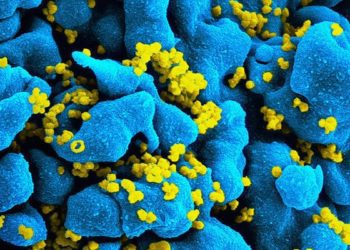Novel colorectal cancer screening tests’ utility depends on patient context
1. Based on a validated model of colorectal cancer screening, cell-free DNA blood tests may deliver net benefit when screening persons who decline alternatives, but net harm when substituting for more effective alternatives.
2. Next-generation multitarget stool DNA and RNA fecal immunochemical tests may achieve similar efficacy as standard fecal immunochemical tests in reducing colorectal cancer incidence and mortality.
Evidence Rating Level: 2 (Good)
Study Rundown: Colorectal cancer (CRC) is the third most diagnosed adult cancer in the United States. While early detection may prevent more than half of CRC-related deaths, 40% of eligible individuals are not up-to-date with their screening in the U.S. The U.S. Preventive Services Task Force (USPSTF) endorses a grade A recommendation for CRC screening in persons aged 50 to 75 years, and a grade B recommendation for persons aged 45 to 49 years. Current screening methods include colonoscopy, the fecal immunochemical test (FIT), and the multitarget stool DNA test (MT-sDNA). However, new blood-based and stool-based tests are emerging, including the cell-free DNA blood test (cf-bDNA), which is commercially available at a list price of $1495. The changing landscape of CRC screening raises questions regarding the clinical and economic impacts of the novel screening tests versus the established alternatives. Hence, using the previously validated MOSAIC (Model of Screening and Surveillance for Colorectal Cancer) model, this study compared the efficacy of novel CRC screening tests, including two different cf-bDNA tests, a next generation multitarget stool DNA (ngMT-sDNA) test, and a FIT-RNA test, to traditional tests such as FIT and colonoscopy. Overall, it found that cf-bDNA may deliver net benefit when used in persons who decline other screening alternatives but does not serve as an effective substitute for established screening tests. The ngMT-sDNA and FIT-RNA tests demonstrated comparable efficacy to standard FIT screening in reducing colorectal cancer incidence and mortality, although the costs of these novel tests have not yet been well-characterized. This study was limited by its inability to account for longitudinal test-specific participation patterns. Overall, these findings helped clarify the potential role of several novel tests in CRC screening.
Click to read the study in AIM
Relevant Reading: A cell-free DNA blood-based test for colorectal cancer screening
In-Depth [prospective cohort]: This probabilistic decision and cost-effectiveness analysis utilized MOSAIC to project reductions in CRC incidence and mortality, as well as the cost-effectiveness associated with novel CRC screening tests versus those of established screening methods. The novel strategies in question consisted of ngMT-sDNA, FIT-RNA, and cf-bDNA (Guardant Shield or Freenome) every 3 years. The established methods included screening colonoscopy every 10 years, annual FIT, and MT-sDNA every 3 years as recommended by the USPSTF. Using the Natural History module from MOSAIC, persons aged 45 were followed in 1-year cycles as they transitioned from health stages including normal; non-advanced polyp; advanced precancerous lesion; localized, regional, or disseminated CRC; and death. The primary model outputs were CRC incidence and deaths, quality-adjusted life-year (QALY), costs, and number of colonoscopies in hypothetical cohorts of 100,000 individuals starting at 45 years of age. Colonoscopy follow-up rates between 40% to 100% were applied for non-invasive screening methods in the model based on true average follow-up rates of 60% for abnormal stool tests in the U.S. Without screening, 7,470 (95% uncertainty interval [UI], 6,606 to 8,322) CRC cases and 3,624 (95% UI, 3,211 to 4,030) CRC deaths occurred in a 100,000-person cohort. When compared with no screening, the relative rates of CRC cases were 0.21 with colonoscopy (UI, 0.19 to 0.22), 0.29 with FIT (UI, 0.27 to 0.31), 0.33 with ngMT-sDNA (UI, 0.32 to 0.36), 0.32 with FIT-RNA (UI, 0.30 to 0.34), 0.58 with Guardant Shield cf-bDNA (UI, 0.55 to 0.61), and 0.58 with Freenome cf-bDNA (UI, 0.55 to 0.60). The relative rates of CRC deaths versus no screening were 0.19 (UI, 0.17 to 0.20), 0.25 (UI, 0.23 to 0.27), 0.28 (UI, 0.27 to 0.30), 0.28 (UI, 0.26 to 0.30), 0.44 (UI, 0.42 to 0.47), and 0.46 (UI, 0.44 to 0.49), respectively. CRC mortality increased when individuals using any of the current screening strategies switched to cf-bDNA but decreased when individuals switched from no screening to cf-bDNA. When screening intervals for the novel tests were decreased from 3 to 2 to 1 years, incremental costs exceeded incremental benefits. Guardant Shield cf-bDNA was found to cost $89,600 (UI, $74,800 to $102,300) per QALY gained compared to no screening. In summary, this analysis demonstrated the potential of novel CRC screening tests and highlighted the importance of shared decision-making in this rapidly evolving landscape.
Image: PD
©2024 2 Minute Medicine, Inc. All rights reserved. No works may be reproduced without expressed written consent from 2 Minute Medicine, Inc. Inquire about licensing here. No article should be construed as medical advice and is not intended as such by the authors or by 2 Minute Medicine, Inc.








